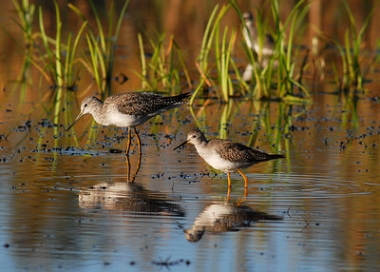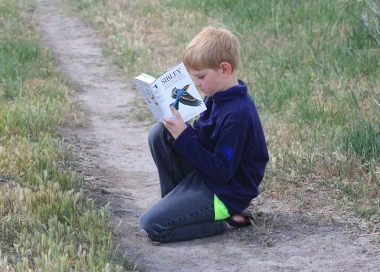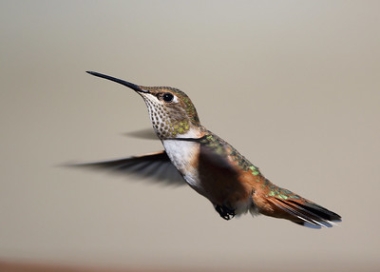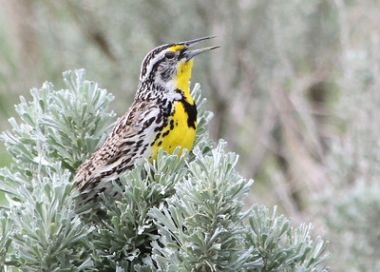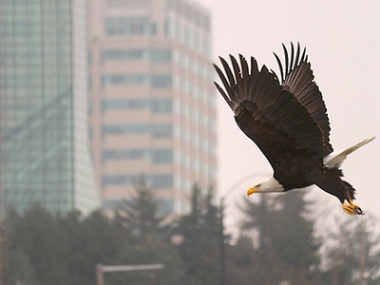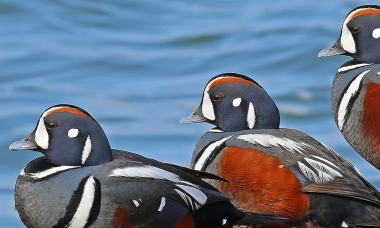
10 tips for beginning birders
Binoculars? Check. Field guide? Check. Now what? Learn the basics for bird watching.

They can be large or small, drab or colorful, water creatures or landlubbers. They can fly to great heights or scurry across open fields. Sometimes they’re here and sometimes they’re not, depending on the season. We’re talking about birds, of course, and there’s something about watching these feathered creatures that people find engaging, fascinating and fun.
Maybe that’s why there are about 16 million active birders in America, according to the U.S. Fish and Wildlife Service. One of them is Carolyn Eckrich, an ODFW wildlife biologist. According to Carolyn, there are lots of things to like about bird watching:
- It helps you disconnect from the day-to-day grind, at the same time it helps you reconnect with nature. Once you start looking and listening to birds, you can’t help but notice all the other little things that are happening around you, like changing seasons, unnoticed features on the landscape, insect life, etc.
- It invites you to be part of a larger birding community. There are clubs, outings, online forums and countless other ways to connect with other birders to learn from and share with.
- You can watch birds almost anywhere – even the artic areas have penguins.
- It’s accessible to almost everyone, regardless of age, fitness level or disability.
- It doesn’t take much gear – just binoculars and a field guide to start with.
Convinced? If so, here are 10 tips to help your bird watching skills take flight. (See what we did there?)
1. Get some binoculars.
It doesn’t take much gear to watch birds, but binoculars are a must. If your budget allows, plan to spend $100-200 on a pair that are sharp and bright enough to see birds in detail. The most popular size for birding is 8x42, which offers a nice balance of magnification and field of vision.
| If you’re buying binoculars with birding in mind, here are two buying guides from the National Audubon Society and Cornell Lab of Ornithology – two groups that know a good bit about watching birds. |
2. Pick a field guide(s) that works for you.
- All-in-one guides, like the Sibley Guide to Birds, offer more comprehensive content and cover the entire country. They are good choices for backyard birding or an at-home reference but are big and bulky to carry in the field.
- Regionally-based field guides, like the Peterson’s Field Guide to Birds of Western North America, aren’t as comprehensive as other guides but are smaller and much easier to carry in the field.
- E-guides, like the Merlin bird ID app from Cornell Lab, are good choices for folks who learn on their phone. It’s easy to use and includes Sound ID that listens to the birds calling around you and offers real time suggestions for who’s singing.
- Go to the library or bookstore and look at a variety of field guides. Pick the one that’s most intuitive to you.
Chances are good that if you get serious about birdwatching, you’ll acquire more than one field guide (you have been warned!), each a little different in format, organization and content.
There are a couple of online resources that can take bird watching to the next level. Allaboutbirds.org by the Cornell Lab is a comprehensive resource to learn about bird ID and behavior. It also offers a number on online birding classes, including the Cornell Lab Bird Academy. eBird.com Northwest is a way for anyone from around the region to share their bird sightings to a central data base. The results are used by scientists working to study and protect bird populations. And by bird watchers to find target birds and birding hotspots. eBird is worldwide and has become known as the “world’s largest birding community.” |
3. Practice using your binoculars.
Before you set up with your binoculars and field guide to start bird watching, take a moment to get to know your new binoculars. Adjust the eye cups and width to your face and get a feel for the focusing wheel.
| Before using your binoculars to find a bird, start looking with your naked eye – this will give you a wider field of vision to scan the area for birds. Look for movement or listen for calls. Once you see a bird, don’t take your eyes off it while you raised the binoculars to your eyes. Practice on stationary objects to see how smoothly and quickly you can find and focus in on them. |
4. Start close to home.
Even if you don’t have a backyard, you can still be a backyard birder. Look for different birds as they travel to and from nearby backyards, empty lots, natural areas and green spaces near your home. Birds will be most active early in the morning, so set up with a cup of coffee, your binoculars and a good view of bird habitat. And start birding.
5. Survey the bird from beak to tail.
When you first spot a bird, resist the urge to immediately reach for your field guide to ID it. Instead, take a few minutes to notice the size and shape of the bird, as well as distinguishing colors or feather patterns.
Coordinate your observations with your field guide. For example, if your guide is organized based on the shape of the bird, study that first. Other field guides focus on plumage (feathers) so studying colors and feather patterns may be more helpful.
6. Do some homework before hitting the road.
While starting close to home is sound advice, there’s a whole bird world out there to explore. State and federal wildlife areas, state and local parks, and natural areas offer opportunities to see a variety of birds. But before you go, find out what to expect:
- Use eBird.com Northwest or other resources to see what birds have been spotted in that location.
- Find a map of the area you want to visit – look for parking, back roads, viewing blinds and trails.
- Go prepared. Remember your binoculars, field guide, creature comforts and patience.
- Set the alarm clock. Birds are most active first thing in the morning.
| The Oregon Department of Fish and Wildlife owns and manages 21 wildlife areas across the state, many of which were created specifically to protect layover spots for migrating birds. |
7. To find diverse birds, set up in areas with diverse habitats.
Forests, wetlands and grasslands all appeal to different bird species. Find an area with two or more habitat types and you can settle in to watch the action.
You don’t need a camouflaged blind to watch birds in a wild area, just wear subdued colors and stay quiet and still. Birds will get used to your presence soon enough and get back to what they were doing. Take a comfortable camp chair and other creature comforts to help extend your time in the field.
8. Master the stroll when hiking.
Power hiking can be great for heart health, but it’s not so good for bird watching. Birds can be hard to spot and are easily spooked, so slow down if you want to see more birds when you’re hiking.
- In dense habitat with lots of trees and shrubs, you may hear the birds before you see them. Keep your ears perked up.
- In open habitat, it’s easier to see birds first.
9. Join a birding community.
By participating in guided hikes, workshops, birding clubs and even digital forums you can learn from experienced birders. And meet fellow newcomers to partner with as you learn more.
10. Do you.
There aren’t any right or wrong ways to go bird watching – just tons of different opportunities. Whether you’re a traditionalist or a digital adopter, a homebody or a world traveler, a quiet individualist or a gregarious people-person, there is a world of birding for you to explore in your own personal way.
Carolyn Eckrich is the ODFW acting strategy species coordinator in LaGrande, OR. Her early education/training as a wildlife biologist, including a class in ornithology, “forced” her to learn something about birds and bird identification. Since then, she has evolved into an avid backyard birder where she watches birds strictly for fun.
Her most memorable bird sightings include tufted puffins in Alaska, greater sage-grouse in Wyoming, sandhill cranes in Indiana and American dippers in Oregon.

